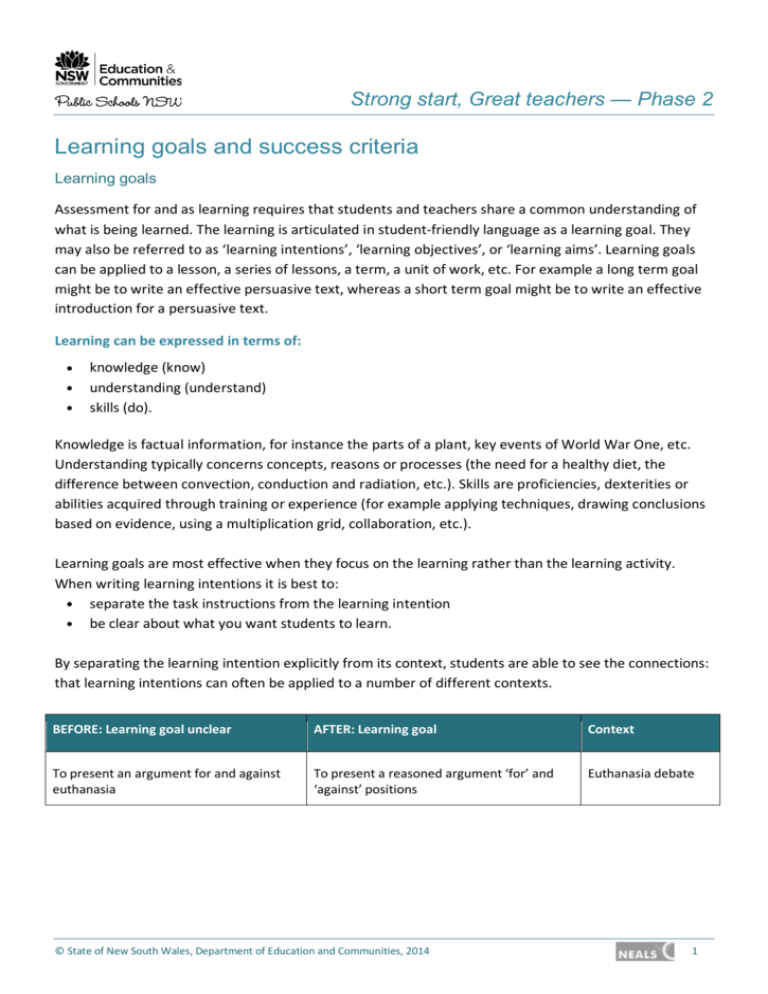Learning goals and success criteria
advertisement

Strong start, Great teachers — Phase 2 Learning goals and success criteria Learning goals Assessment for and as learning requires that students and teachers share a common understanding of what is being learned. The learning is articulated in student-friendly language as a learning goal. They may also be referred to as ‘learning intentions’, ‘learning objectives’, or ‘learning aims’. Learning goals can be applied to a lesson, a series of lessons, a term, a unit of work, etc. For example a long term goal might be to write an effective persuasive text, whereas a short term goal might be to write an effective introduction for a persuasive text. Learning can be expressed in terms of: • • • knowledge (know) understanding (understand) skills (do). Knowledge is factual information, for instance the parts of a plant, key events of World War One, etc. Understanding typically concerns concepts, reasons or processes (the need for a healthy diet, the difference between convection, conduction and radiation, etc.). Skills are proficiencies, dexterities or abilities acquired through training or experience (for example applying techniques, drawing conclusions based on evidence, using a multiplication grid, collaboration, etc.). Learning goals are most effective when they focus on the learning rather than the learning activity. When writing learning intentions it is best to: • separate the task instructions from the learning intention • be clear about what you want students to learn. By separating the learning intention explicitly from its context, students are able to see the connections: that learning intentions can often be applied to a number of different contexts. BEFORE: Learning goal unclear AFTER: Learning goal Context To present an argument for and against euthanasia To present a reasoned argument ‘for’ and ‘against’ positions Euthanasia debate © State of New South Wales, Department of Education and Communities, 2014 1 Success criteria Success criteria describe in specific terms what successful achievement of the learning goal looks like. They help students recognise if they have been successful in their learning. The most significant benefits of success criteria are that they can help to cultivate independent learners, provide effective feedback and create confident students who contribute to activities. When students have success criteria at hand, they are more informed about how they will be assessed. Consequently, they are better able to assess their own and others’ work to identify successes and areas for improvement. Success criteria also allow you and the students to give accurate feedback – they keep you both focused on the criteria that the work will be assessed against. Best practice suggests that you discuss and agree to success criteria with the students in advance of the learning experiences. Success criteria can be used to develop an assessment tool such as a checklist, rubric, etc. Example: Geography Year 10 Learning objective Context Success criteria To know ways of controlling drought Savannah grassland What I am looking for: • List the different causes of drought • Explain how these could be reduced • List your recommendations for how people can cope and live with drought • Make comparisons with drought in Australia Example: English Year 7 Learning objective Context Write Letter to local MP persuasively using regarding culling of different kangaroos techniques Success criteria What I am looking for: • A statement of your viewpoint • A number of reasons for this with evidence • A number of reasons from an alternative standpoint • Attempts at striking up empathy with the recipient • Recommended alternative action • A summary • Reasoning connectives From Clarke, S. (2005). Formative Assessment in the Secondary Classroom. London: Hodder Murray. © State of New South Wales, Department of Education and Communities, 2014 2











